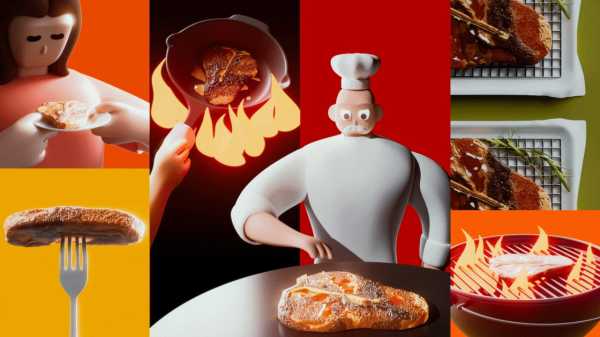
Save this storySave this storySave this storySave this story
Things that scare me in the kitchen: mandolines, lighting a gas hob with a matchstick, onions, chicken-washing discourse, people who want to help, cooking with or without a timer, post-lasagna washing up. My biggest enemy is the smoke alarm, a benevolent tyrant whom I’ll do anything to appease, and the reason that I don’t like to make toast and won’t, under any circumstances, flambé. My partner is an excellent cook, but I wince when he says that he’s going to cook meat. “I need to get a good sear on it,” he’ll argue while I open the windows. I move on to bargaining—does fat really need to be rendered? Who’s to say that steak has to be cauterized like that? He’s vindicated at the table: I can’t argue with the intense savory quality of meat cooked over a quick, fierce heat. About seventy per cent of all human culinary ingenuity has been in pursuit of a flavor that can roughly be described as “delicious brown.”
This flavor comes from the Maillard reaction, a chemical process that occurs when amino acids—the building blocks of protein—and simple sugars are brought together over heat. At a temperature somewhere between the boiling point of water and the point at which sugar begins to caramelize, a transformation occurs, with the heat building simple compounds into arrangements with the complexity of a public-transit map. This structural intricacy leads to bigger, multivalent flavors. If you want to know what the Maillard reaction ends up tasting like, you need only look at more or less anything that has transformed from beige into shades of tan, umber and chestnut: sourdough crusts, coffee, beer, seared meat. This is the root of French classical cooking, a depth that Adam Gopnik calls a “fat organ chord in a tall church.”
Louis Camille Maillard, a French chemist, first made sense of the reaction in 1912, but it has been part of cooking for as long as humans have been cooking with fire. It seems ridiculous then to accuse the Maillard reaction of “having a moment,” but it’s hard not to notice. French cuisine is back in vogue, which means the return of the layered brownness of meat and sauce. In the micro-era of the medium-rare gourmet burger, the essence of the patty was the meat; now in the smashburger age it’s all about the sear. At hype spots like Hamburger America, the seasoned ground meat is smeared as thin as possible onto the grill, so that instead of a patty what you get is a disk of undifferentiated crisp. Social media has certainly played its part: the reaction is like a chemical Photoshop that gives you more flavor saturation and textural contrast but also dials up the visual sharpness of a dish.
The biggest development, though, has been the reaction to the reaction. It has broken out of the hard-theory ghettos of sourdough discussion boards and now circulates on the cusp of common parlance. We’ve arrived at a point where J. Kenji López-Alt, one of the Internet’s most successful food-science tacticians, can drop the term in the New York Times without having to explain it. The Maillard reaction has become a fixture of the new cross-cultural, science-inflected culinary Esperanto. Look at TikTok and you’ll find an inexhaustible feed of videos about Maillardian chemistry in every language and from every faction of the food-culture matrix. Last year, “Maillard makeup” became a viral trend on Chinese social media platforms: a soft color palette of tan, taupe, and umber, inspired by the reaction but not exactly capturing its intensity.
The scientification of home cooking has been in the works for a while, especially since publishers have realized that “kitchen science” is a marketable theme, in the same way Italian or microwave cooking is. López-Alt collated his research in “The Food Lab,” published in 2015. Samin Nosrat’s Galenic “Salt, Fat, Acid, Heat” became a best-seller a couple of years later, as did Nik Sharma’s “The Flavor Equation” shortly after that. Thanks to these cookbooks and the digestible science of social media, home cooks have started talking about caramelization, fermentation, and more. The Maillard reaction has joined these “-ations” in the conscientious home cook’s vocabulary. Having a common technical language suits the eclecticism of modern food. If you’re borrowing miso from the Japanese repertoire and adding it to a French caramel au beurre salé, it helps to have a shared lexicon to make sense of why these things work together.
Still, one can take things too far. Even my friend Feroz Gajia, a chef who deploys the Maillard reaction as well as anyone I know, is skeptical of all the hype. “Maillard has basically become the new umami,” he told me via text, “shorthand for ‘I know wtf I’m talking about, bow to me.’ ” It seems that a process once known as “browning” has been coöpted by an Internet-inflected school of culinary machismo, where the primary function of cooking isn’t necessarily feeding people but, rather, proving a point. Recently, the Instagram algorithm presented me with a Maillard-reaction explainer video from the restaurant where I ate one of the more disappointing meals of the past year, a chiaroscuro rendering of deeply charred meat and too-intense umami. As Feroz told me, it’s a flavor profile that—just like sweetness—has diminishing returns.
Looking for a way of cooking that won’t fry my nerves, I’ve turned my focus from fire to water. Shizuo Tsuji’s “Japanese Cooking: A Simple Art,” published in 1980, was one of the first mainstream Japanese cookbooks for American readers. Unlike “Mastering the Art of French Cooking” or Elizabeth David’s “A Book of Mediterranean Food,” which are organized by ingredient, “Japanese Cooking” is arranged according to process. A whole chapter is dedicated to steamed dishes—mushimono—such as a savory egg custard enriched with trefoil leaves, chicken and ginkgo nuts. Another is about simmered dishes—nimono—including a painterly assemblage of shrimp, squash, and spinach, each separately cooked in a dashi- and mirin-based stock. These dishes still involve the concentrated Maillardian flavors of dashi and soy sauce, but the savory depth serves as a counterpoint to the flavors of the fish, not the main event.
In “Invitation to a Banquet,” a book about the history of Chinese cooking, Fuchsia Dunlop reminds us that every cuisine has its own grammar, and sometimes these methods map onto language. The French “don’t have a specific word for steaming—they just call it ‘cooking with vapor’ (cuisson à la vapeur).” In Chinese cookery, steaming can be many things: dùn steaming uses direct steam, and zhēng is indirect; beyond that, qīng zhēng—or clear steaming—brings ingredients like fresh fish into contact with the steam, whereas fěn zhēng involves coating the ingredient in tapioca or rice flour to mediate the heat and keep juices in. All of these work in service of the “yuán wèi, the essential flavors of the ingredients.” Steaming also serves texture: the lure of cheung fun is how the rice-based sheets gelatinize into a slippery, ungraspable skein; steamed buns have a tight bounce but only a satin pellicle outside. It’s economical to cook this way: unlike the profligate theatrics of a grill, a stack of bamboo steamers is a closed system, and an entire dinner can be cooked over a single flame.
Cooks are beginning to quietly react against the provocations of the Maillard reaction. Lately I’ve seen more boiled dishes on menus—things like leeks vinaigrette, in which trimmed leeks are boiled whole and then dressed. The recipe developer Christina Chaey writes a popular newsletter focussed on “gentle foods,” which are, by her description, usually “warm things of the brothy/runny/creamy/velvety nature.” I knew something was really afoot when Laila Gohar, an artist whose Insta-famous food styling is the aesthetic of the moment, nailed her colors to the mast. In the Financial Times, she shared a recipe for a bollito misto, an Italian beef-and-vegetable boil, her version taking on the exacting composition of a Malevich painting. “Sure,” she wrote, “meat kissing a searing-hot grill gives it a sexy smokiness . . . but to me the simplest, most delicious type of cooking requires only two things: a pot and water.”
I’ve enjoyed the slower transformations of this way of cooking. Recently, I made a saffron-and-currant pudding with a delicate crumb and the concentrated aromatics that can come only from entrapping a food with its own steam. (A British pudding is like a cake, but wrapped and cooked over water.) I also followed a recipe from my friend Melek Erdal, a Kurdish Alevi food writer, for terbiyeli soup with simmered lamb-and-rice meatballs; for another dinner, I made chicken poached in stock and finished with fresh tarragon, dill, and parsley. “Compared with the adrenalin-fuelled drama of stir-frying,” Dunlop writes, “steaming is an easy way to cook, relaxed and forgiving.” When I’m composing a tableau in a pan of stock, I have the unpunctured mental clarity that can only come from knowing, for sure, that the smoke alarm will not go off. ♦
Sourse: newyorker.com






